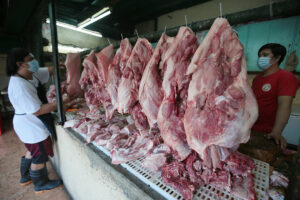Pork prices to remain high due to cost of feed, lingering ASF

— PHILIPPINE STAR/ MICHAEL VARCAS
By Adrian H. Halili, Reporter
PORK PRICES are expected to remain higher until next year, with feed still expensive and African Swine Fever (ASF) lingering in some regions.
“Unless biosecurity measures are installed, which only the big raisers can afford, pork supply will remain unstable. With a growing population, demand will simply outstrip supply,” Former Agriculture Undersecretary Fermin D. Adriano said in a Viber message.
“Prices will remain elevated,” Mr. Adriano added.
In October, the Department of Agriculture said it is currently in various stages of testing ASF vaccines, with four companies seeking to introduce their products on the market.
Mr. Adriano said that the recent extension of lowered tariffs on commodities like pork, rice, and corn will only ease the supply problem “a little.”
On Tuesday, the government approved the extension of lowered pork tariffs at 15% for imports within the minimum access volume (MAV) quota and 25% for those exceeding the quota. The extension of the low-tariff regime was implemented via Executive Order 50.
Additionally, tariff rates for rice remained at 35% regardless of source or volume, while corn was kept at 5% for shipments within the MAV quota and 15% for those exceeding the quota.
“But with costs of feed ingredients like corn and wheat continually rising, there is no way that pork prices will decline to their old levels,” he said.
Edwin C. Mapanao, president of the Philippine Association of Feed Millers, Inc. said in an e-mail that the feed mill industry is currently facing challenges in sourcing raw materials.
Mr. Mapanao added that there is still a need to increase the volume of corn imports to address the deficit of about 2 to 3 million metric tons annually.
The group has called for a standard 5% tariff on corn imports, regardless of volume.
He said corn imports would do more to improve the competitiveness of the livestock industry, as against allowing more meat imports.
Yellow corn makes up 40% to 60% of animal feed. Feed accounts for about 60% of the cost to grow farm animals.
“While other matters impact our competitiveness, addressing feed input sufficiency will certainly improve the livestock situation,” Mr. Mapanao said.
He added that the lowered tariffs should not have included meat, as the measure has impacted the livestock industry.
“We believe that this should not be the case considering that it displaces the food value chain by discouraging the expansion of meat producers,” Mr. Mapanao said.




